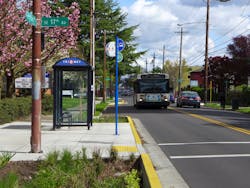During the last two years, more than 370 TriMet bus stops have seen improvements, with additional projects underway or in the planning stage for another 100 stops. Concerned yours isn’t one of them? Consider this: TriMet has 6,660 stops throughout a 533 square-mile service district and the vast majority of them are on property not owned by TriMet. Improvements to our bus stops require help from our city, county and state partners; private property owners and riders.
The agency excited about the improvements made recently, which range from adding landing pads and lighting, to putting in seating and shelters, to installing sidewalks and safer crossings treatments; but there’s more work to be done. They hear that from some riders who use less than stellar stops and we saw that with photos sent to The Oregonian recently.
My bus stop needs help
The biggest issues that we hear about bus stops are related to access, amenities and trash. Let’s dig deeper into each of those starting with the most common complaint – access.
Getting to/from the bus stop
Before riders get on board a TriMet bus, you have to get to the bus stop. “Every transit rider is a pedestrian, first and last, but accessing transit isn’t always easy,” says Alan Lehto, TriMet director of planning and policy development.
Walking with your child along a roadside ditch to a bus stop is a much different experience than strolling along a wide sidewalk with a landscaped buffer between the roadway and you. Waiting next to a bus stop pole in the middle of TV Highway is a world away from waiting in a lit up bus shelter connected to a wide sidewalk. “Access is a critical part of what makes transit work but we don’t have control over it,” says Lehto.
Many areas throughout the TriMet service district may lack the infrastructure for bus stops, but there is still a need to provide transit service to nearby neighborhoods, especially in low income areas where many are transit dependent. So you may see a bus stop pole in a less than ideal location to provide nearby residents with service without making them walk long distances in areas without sidewalks.
In 2012, TriMet released the Pedestrian Network Analysis. It highlights some of those areas with the most need and the most opportunity for pedestrian improvements that would make it easier for people to ride transit. The analysis lays the groundwork for the public and private partnerships and investments necessary to make those improvements possible.
While improvements have been made to hundreds of bus stops in the past two years, more are coming. Recently, TriMet successfully led our jurisdictional partners to secure funding for projects that will create better access for many bus stops in three corridors in the region: Powell-Division, Barbur-99W and Highway 8 from Beaverton to Hillsboro. The money, about $6.5 million, comes from the Oregon Department of Transportation’s (ODOT) competitive Statewide Transportation Improvement Program’s (STIP) Enhance funding process. While ODOT will provide the majority of the money using flexible federal funds, TriMet and the local jurisdictions contribute about 10 percent in matching funds. Learn about the Corridor Safety & Access to Transit projects.
TriMet continues to work with our partners to make improvements that will increase and make access to transit better throughout the region.
Thousands of bus stops are spread out in neighborhoods throughout the TriMet service district, on land adjacent to private property or in parking strips. These are stops where benches and shelters may not fit physical or stylistically. TriMet takes the setting, space and ridership into consideration when determining if amenities are warranted. Shelters are considered only at stops with at least an average 50 weekday boarding rides.
Trashing my bus stop
Riders don’t like stops strewn with trash and neither does Trimet. Litter is one of the most common complaints it hears about bus stops – and it’s preventable. If there’s not a trash can or the can is full, don’t litter. It’s unsightly and illegal. Please pack your trash with you.
With more than 6,600 stops spread out throughout three counties, TriMet is only able to maintain trash cans at bus stops with shelters and the very highest of ridership. While it does its best to stay on top of litter and vandalism, it’s a huge task and the agency appreciates individuals who take it upon themselves to pick up the random cup tossed on the ground at a stop, or businesses and community organizations that volunteer to help us maintain litter-free stops.
Through our Adopt-a-Stop program, TriMet works with more than 160 volunteers to provide trash cans at some 200 bus stops. In this program, TriMet provides a can with a plaque thanking the group for their sponsorship. The business, church, community group or other organization agrees to empty the trash can as needed. If there is damage or graffiti to the can, TriMet takes care of it.

